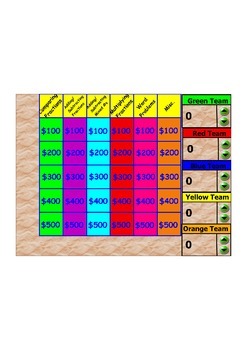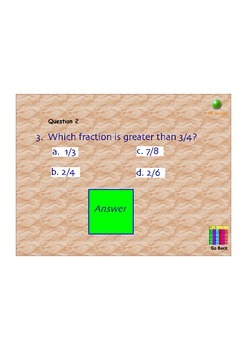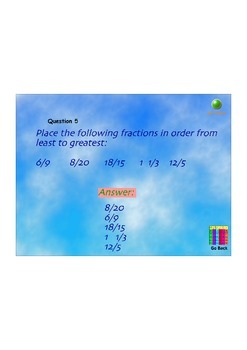Fraction Jeopardy Review Flipchart - Comparing, Adding/Subtracting/Multiplying
Ryan B
243 Followers
Grade Levels
4th - 6th
Subjects
Resource Type
Standards
CCSS4.NF.A.1
CCSS4.NF.A.2
CCSS4.NF.B.3
CCSS4.NF.B.3a
CCSS4.NF.B.3b
Formats Included
- Flipchart File
Pages
61 pages
Ryan B
243 Followers
Description
This is a Fraction Jeopardy Review Flipchart that I use to review fractions.
I have aligned this jeopardy to the common core for both 4th and 5th grade.
Some of the $400/$500 questions are challenging (as they should be!) so this can be used for higher grades as well.
The following standards are met:
4.NF.A.1
4.NF.A.2
4.NF.B.3
4.NF.B.3a
4.NF.B.3b
4.NF.B.3c
4.NF.B.3d
4.NF.B.4a
4.NF.B.4
4.NF.B.4b
4.NF.B.4c
5.NF.A.1
5.NF.B.4
The categories are as follows:
Comparing Fractions: Works with comparing fractions or identifying equivalent fractions.
Adding/Subtracting Fractions: Adding proper/improper fractions with like and unlike denominators.
Adding/Subtraction Mixed Numbers: Adding and Subtracting mixed numbers with like and unlike denominators.
Multiplying Fractions: Multiplying fractions by whole numbers.
Word Problems: Word problems including all operations with fractions.
Misc: Can include parts of other categories, but also focuses on number lines, and visuals with fractions.
The game is set up for 5 teams/players, and the answers are covered and can easily be uncovered to unveil the answer. I usually have them in teams - and give them time to work independently, then time to discuss as a group. Students LOVE playing any form of jeopardy.
There are a total of 30 questions.
Enjoy!
I have aligned this jeopardy to the common core for both 4th and 5th grade.
Some of the $400/$500 questions are challenging (as they should be!) so this can be used for higher grades as well.
The following standards are met:
4.NF.A.1
4.NF.A.2
4.NF.B.3
4.NF.B.3a
4.NF.B.3b
4.NF.B.3c
4.NF.B.3d
4.NF.B.4a
4.NF.B.4
4.NF.B.4b
4.NF.B.4c
5.NF.A.1
5.NF.B.4
The categories are as follows:
Comparing Fractions: Works with comparing fractions or identifying equivalent fractions.
Adding/Subtracting Fractions: Adding proper/improper fractions with like and unlike denominators.
Adding/Subtraction Mixed Numbers: Adding and Subtracting mixed numbers with like and unlike denominators.
Multiplying Fractions: Multiplying fractions by whole numbers.
Word Problems: Word problems including all operations with fractions.
Misc: Can include parts of other categories, but also focuses on number lines, and visuals with fractions.
The game is set up for 5 teams/players, and the answers are covered and can easily be uncovered to unveil the answer. I usually have them in teams - and give them time to work independently, then time to discuss as a group. Students LOVE playing any form of jeopardy.
There are a total of 30 questions.
Enjoy!
Total Pages
61 pages
Answer Key
N/A
Teaching Duration
N/A
Report this resource to TPT
Reported resources will be reviewed by our team. Report this resource to let us know if this resource violates TPT’s content guidelines.
Standards
to see state-specific standards (only available in the US).
CCSS4.NF.A.1
Explain why a fraction 𝘢/𝘣 is equivalent to a fraction (𝘯 × 𝘢)/(𝘯 × 𝘣) by using visual fraction models, with attention to how the number and size of the parts differ even though the two fractions themselves are the same size. Use this principle to recognize and generate equivalent fractions.
CCSS4.NF.A.2
Compare two fractions with different numerators and different denominators, e.g., by creating common denominators or numerators, or by comparing to a benchmark fraction such as 1/2. Recognize that comparisons are valid only when the two fractions refer to the same whole. Record the results of comparisons with symbols >, =, or <, and justify the conclusions, e.g., by using a visual fraction model.
CCSS4.NF.B.3
Understand a fraction 𝘢/𝘣 with 𝘢 > 1 as a sum of fractions 1/𝘣.
CCSS4.NF.B.3a
Understand addition and subtraction of fractions as joining and separating parts referring to the same whole.
CCSS4.NF.B.3b
Decompose a fraction into a sum of fractions with the same denominator in more than one way, recording each decomposition by an equation. Justify decompositions, e.g., by using a visual fraction model. Examples: 3/8 = 1/8 + 1/8 + 1/8; 3/8 = 1/8 + 2/8; 2 1/8 = 1 + 1 + 1/8 = 8/8 + 8/8 + 1/8.





